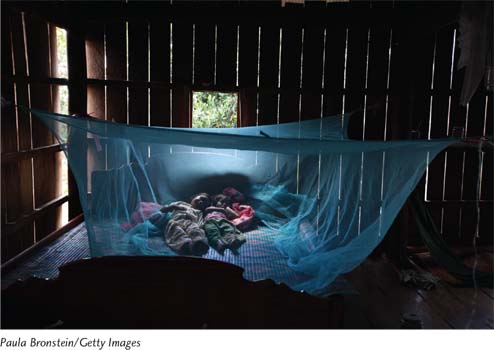working toward  sustainability
sustainability
618
The Global Fight Against Malaria
Bill Gates is best known as the founder of Microsoft, the computer software company, but he is also an active philanthropist. In 2007 he stood up in front of a large group of scientists in Seattle, Washington, and declared that the world needed to eradicate malaria. In challenging the scientists of the world, he asked, “Why would anyone want to follow a long line of failures by becoming the umpteenth person to declare the goal of eradicating malaria?”

Bill Gates knew the history of malaria. People have died from this disease for thousands of years. In modern times, 350 million to 500 million people are infected each year and 1 million of them die. Most malaria cases are in Africa and most of those who die are children. Several eradication efforts have been attempted over the past 6 decades, mostly focused on eliminating the mosquitoes that carry the malaria pathogen. In the United States, eradication was achieved in 1951 through widespread spraying of the insecticide DDT as well as numerous other public health measures. The spraying program became controversial in the 1960s and 1970s because DDT was found to be widely distributed around the globe and it was linked to the thinning of egg shells in large birds of prey due to bioaccumulation and biomagnification. DDT is still sprayed in many parts of the world to assist in the eradication of malaria, but malaria persists.
Malaria is difficult to combat for a number of reasons. First, mosquito populations that are reduced by spraying insecticides can rebound quickly. In Sri Lanka, for example, consistent spraying to kill mosquitoes reduced the number of malaria cases from 1 million to a mere 18. Because of this great success, the spraying program was stopped, but within a few years, malaria cases rapidly increased to a half million. In short, the spraying program was ended before the job was done. Moreover, if one country is spraying to kill mosquitoes and neighboring countries are not, mosquitoes will continue to enter from the neighboring countries. Mosquitoes can rapidly evolve resistance to insecticides such as DDT. The malaria pathogen can rapidly evolve resistance to antimalarial drugs. Finally, eradicating malaria is expensive. Typically, countries use multiple strategies including insecticide spraying, antimalarial drugs, and the distribution of mosquito tents in which people can sleep and avoid being bitten during the night. Collectively, these strategies can carry a price tag that many low-
619
So in 2007, after so many past failures, why did Bill Gates think there was now a possibility of eradicating malaria? Earlier that year, scientists had reported that a new drug, combined with a new style of mosquito net, produced large reductions in malaria cases—
The Bill and Melinda Gates Foundation funds projects that have been historically underfunded. Equally important, by throwing its prominent name and financial resources behind a cause like malaria eradication, the foundation can rally significant financial support from other foundations and from developed countries. Western governments joined the movement and increased malaria funding from $50 million to $1.1 billion. This gave new hope to the declared goal of eradicating malaria from the globe within 50 years.
Many challenges remain. One of the largest is simply organizing distribution systems to hand out the drugs and millions of mosquito tents. In some regions, there are no roads into the villages and the items must be brought there by foot or by boat. There is also the challenge to continue research into new strategies against the pathogen and the mosquito. Currently, a new antimalaria drug from China has proven very effective against the pathogen and is quite inexpensive to manufacture. The manufacturer of this drug agreed to sell it at less than the cost of manufacturing it, making the drug a very attractive option for low-
Another possibility is the development of a vaccine that would provide immunity to malaria infections. For nearly 25 years, the pharmaceutical company GlaxoSmithKline spent more than $350 million to develop a malaria vaccine, but the company was reluctant to fully fund a study of the effectiveness of the vaccine in African children. The Gates Foundation provided $200 million to help fund the study and the results have been very encouraging. In 2013, it was announced that children vaccinated between 5 and 17 months of age experienced 46 percent fewer cases of malaria than similar children who were not vaccinated. The researchers conducting the study will continue to follow these children as part of a prospective study to determine if the vaccination continues to protect the children throughout their lives.
Today there is tremendous hope that Bill Gates’s dream of eradicating malaria is gaining ground. Most experts agree that malaria cases could be reduced by at least 85 percent in most African countries. The reduction in illness and death would also be highly beneficial to the economies of these low-
Critical Thinking Questions
If mosquitoes vary in their resistance to insecticides, what might you predict about the long-
term success of trying to eliminate all of the mosquitoes with insecticide as a way to eliminate malaria? How might a reduction in illness and death from malaria affect the economies of low-
income countries in terms of future health costs and the health and productivity of their workforce?
References
Editorial Board. 2013. Hope for a malaria vaccine. New York Times, October 13. http:/
Kingsbury, K. 2009. A better deal on malaria. Time, February 26. http:/
McNeil, D., Jr. 2008. Nets and new drug make inroads against malaria. New York Times, February 1. http:/
McNeil, D., Jr. 2008. Eradicate malaria? Doubters fuel debate. New York Times, March 4. http:/